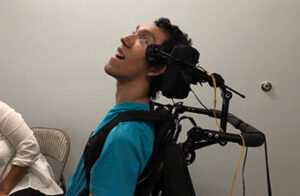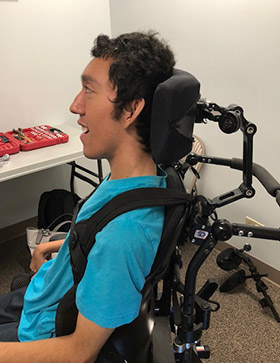Dynamic Head Support Hardware and Head Position – Can One Help the Other?
Michelle L. Lange, OTR/L, ATP/SMS
updated 11/11/2024.

Jonathan in a hyperextended neck position.
Many clients who benefit from Dynamic Seating specifically benefit from movement at the neck. This may include clients who forcefully extend at the neck or who bang against the head support repeatedly, often in conjunction with a total body rocking movement. In either case, the head support moves in response to client forces to reduce tone and impact forces.
Impact on Neck and Head Position
When the head support does not move in response to force, the client may actually leverage off of this static surface, pushing the trunk forward and hyperextending the neck. Using anterior trunk supports, such as shoulder straps, can minimize the neck hyperextension, but not the amount of force exerted.
One concern about allowing movement at the neck through Dynamic Seating is the many clients will move into a hyperextended neck position, despite anterior trunk support. This position can actually further increase extension, negatively impact breathing and swallowing, and leave the client looking up at the ceiling.
Preventing Neck Hyperextension
So how do we provide movement, but limit neck hyperextension? Here are a few suggestions:
- Anterior trunk support. Much of positioning involves force and counterforce. The anterior trunk support will help maintain a neutral neck posture, even during movement. It provides counter force at the anterior trunk to the posterior support at the head.
- Appropriate resistance. If the resistance is inadequate, the client may be able to ‘overpower’ the dynamic component and assume a hyperextended position.
- Adjustment. The entire head support needs to be adjusted so that the client is less likely to assume neck hyperextension at rest or during activation of the dynamic component.
- Design. A variety of dynamic head support options are available. Some allow movement into neck hyperextension. Carefully examine the available movement to ensure that neck hyperextension is not likely from a design standpoint.

Neutral neck position following changes to resistance and hardware adjustment.
Optimizing Head Position
It is critical to choose the optimal Dynamic Head Support option, determine appropriate resistance levels, and adjust the head support hardware position. Optimizing head position is very dependent upon the client’s overall positioning within the seating system. Once the seating system is determined, a specific head support is chosen. This may include occipital, suboccipital, and lateral support pads. Most Dynamic Seating options at the head work with a variety of head support pads.
Looking for more information about head positioning? Check out our on-demand course on Positioning the Head here!
Have you found improvements in head position when using Dynamic Seating interventions? I’d love to hear from you! Please leave your comment below!
